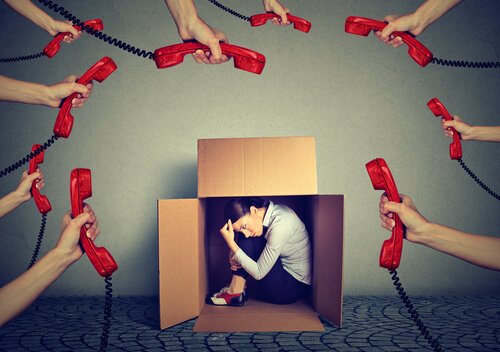Ergophobia: Fear of Work

There are hundreds of phobias, some better-known than others. One of these many phobias is called ergophobia. Ergophobia is a specific phobia. It is characterized by an irrational and excessive fear of work.
People with ergophobia experience high levels of anxiety when they have to go to work. Their fear is such that they have to leave early. In severe cases, it prevents them from going to their workplace at all.
What are the characteristics of phobias?
The definition of a phobia is intense or irrational fear of an object or situation that is not dangerous. The word comes from the Greek term phobos, which means “panic.”
In Greek mythology, Phobos was also the son of Aries, god of war, and Aphrodite, the goddess of love. He personified fear. Alexander the Great prayed to Phobos before each battle to rid himself of fear.
Ergophobia is a specific phobia. People with specific phobias suffer fear and anxiety of clearly defined objects or situations. These are called phobic stimulants. In this case, the stimulants are al those related to going to work or being at work.

Ergophobia, just like other specific phobias, has particular characteristics. In general, all specific phobias share the following characteristics:
- Fear or intense anxiety relating to a specific object or situation (i.e. flying, heights, animals, needles, blood, etc.)
- The object or situation that causes the phobia always produces immediate fear or anxiety.
- People with a phobia avoid or actively resist the situation or object in question with fear or intense anxiety.
- The fear or anxiety is disproportionate to the actual danger that the object or situation presents, and the sociocultural context.
- The anxiety, fear, or avoidance causes clinically significant problems. These problems can be in the context of work, social life, or other functionally important areas.
People often have multiple specific phobias. Approximately 75% of people with specific phobia fear more than one situation or object.
Specific characteristics of ergophobia
Anyone can experience different levels of anxiety at work. Work-related anxiety is not pathological and can even be normal. It depends on the kind of job that you have. In other words, these feelings have a relationship with the characteristics of your work.
However, people with ergophobia are irrationally and excessively afraid of their workplace. This type of fear is much greater than what a normal working person experiences. In addition, people with ergophobia recognize that their fear isn’t rational. They know it is disproportionate to the situation.
An individual suffering from ergophobia is aware that their anxiety about work is irrational. They don’t need someone to tell them this. In spite of that, they can’t avoid feeling a paralyzing fear most of the time. They are incapable of controlling his anxiety. The fear and anxiety appear automatically when they are confronted with the threatening stimulus, and they panic. There is almost nothing they can do to make it better.

To qualify as ergophobia, the individual has to feel a persistent fear towards work. That means that they are always afraid of work, even if the workplace or the type of work changes.
Another characteristic of ergophobia is avoidance. Individuals with ergophobia try to avoid triggers associated with work at all costs. In worst-case scenarios, they can lose their jobs.
Causes of ergophobia
Ergophobia develops through the same mechanisms as other specific phobias. One cause could be a negative or traumatic experience at work. But that’s not the only cause. Phobias can also be “learned” through other mechanisms.
People can acquire phobias directly or indirectly. Acquisition is direct when the individual has some kind of negative experience themselves. The acquisition is indirect when they witness a traumatic event. Alternatively, someone tells them about one. It is most likely that individuals with ergophobia have had a direct conditioning experience.
A conditioning experience is an association between two stimuli. When stimulus 1 happens, stimulus 2 appears. In the case of ergophobia, stimulus one is a frightening experience at work, As a result, they associate their workplace with this negative experience.
As a result, the stimuli related to the workplace acquire the negative properties of the bad experience. So, every time the person faces anything related to work, they react with anxiety. That can mean restlessness, fear, catastrophic thoughts, sweating, etc.
Since the individual wants to avoid or escape these anxiety responses, they start to avoid anything related to the workplace. Everytime they manage to avoid or escape, they feel better. Consequently, they learn that avoiding or escaping gives them peace and well-being.

Is there a cure for ergophobia?
The treatment for ergophobia, just like the rest of the specific phobias, is quite specific. The treatment of choice for any phobia is exposure therapy with response prevention. If you expose yourself to the stimulus, you can decrease anxiety and break the association that we discussed above.
Do you think you might be suffering from ergophobia? If so, we recommend that you see a psychologist. Look for one who specializes in phobias. They will give you the steps to follow so you can get back to normal. They will help you be able to go work without any problems, just like you did before.
There are hundreds of phobias, some better-known than others. One of these many phobias is called ergophobia. Ergophobia is a specific phobia. It is characterized by an irrational and excessive fear of work.
People with ergophobia experience high levels of anxiety when they have to go to work. Their fear is such that they have to leave early. In severe cases, it prevents them from going to their workplace at all.
What are the characteristics of phobias?
The definition of a phobia is intense or irrational fear of an object or situation that is not dangerous. The word comes from the Greek term phobos, which means “panic.”
In Greek mythology, Phobos was also the son of Aries, god of war, and Aphrodite, the goddess of love. He personified fear. Alexander the Great prayed to Phobos before each battle to rid himself of fear.
Ergophobia is a specific phobia. People with specific phobias suffer fear and anxiety of clearly defined objects or situations. These are called phobic stimulants. In this case, the stimulants are al those related to going to work or being at work.

Ergophobia, just like other specific phobias, has particular characteristics. In general, all specific phobias share the following characteristics:
- Fear or intense anxiety relating to a specific object or situation (i.e. flying, heights, animals, needles, blood, etc.)
- The object or situation that causes the phobia always produces immediate fear or anxiety.
- People with a phobia avoid or actively resist the situation or object in question with fear or intense anxiety.
- The fear or anxiety is disproportionate to the actual danger that the object or situation presents, and the sociocultural context.
- The anxiety, fear, or avoidance causes clinically significant problems. These problems can be in the context of work, social life, or other functionally important areas.
People often have multiple specific phobias. Approximately 75% of people with specific phobia fear more than one situation or object.
Specific characteristics of ergophobia
Anyone can experience different levels of anxiety at work. Work-related anxiety is not pathological and can even be normal. It depends on the kind of job that you have. In other words, these feelings have a relationship with the characteristics of your work.
However, people with ergophobia are irrationally and excessively afraid of their workplace. This type of fear is much greater than what a normal working person experiences. In addition, people with ergophobia recognize that their fear isn’t rational. They know it is disproportionate to the situation.
An individual suffering from ergophobia is aware that their anxiety about work is irrational. They don’t need someone to tell them this. In spite of that, they can’t avoid feeling a paralyzing fear most of the time. They are incapable of controlling his anxiety. The fear and anxiety appear automatically when they are confronted with the threatening stimulus, and they panic. There is almost nothing they can do to make it better.

To qualify as ergophobia, the individual has to feel a persistent fear towards work. That means that they are always afraid of work, even if the workplace or the type of work changes.
Another characteristic of ergophobia is avoidance. Individuals with ergophobia try to avoid triggers associated with work at all costs. In worst-case scenarios, they can lose their jobs.
Causes of ergophobia
Ergophobia develops through the same mechanisms as other specific phobias. One cause could be a negative or traumatic experience at work. But that’s not the only cause. Phobias can also be “learned” through other mechanisms.
People can acquire phobias directly or indirectly. Acquisition is direct when the individual has some kind of negative experience themselves. The acquisition is indirect when they witness a traumatic event. Alternatively, someone tells them about one. It is most likely that individuals with ergophobia have had a direct conditioning experience.
A conditioning experience is an association between two stimuli. When stimulus 1 happens, stimulus 2 appears. In the case of ergophobia, stimulus one is a frightening experience at work, As a result, they associate their workplace with this negative experience.
As a result, the stimuli related to the workplace acquire the negative properties of the bad experience. So, every time the person faces anything related to work, they react with anxiety. That can mean restlessness, fear, catastrophic thoughts, sweating, etc.
Since the individual wants to avoid or escape these anxiety responses, they start to avoid anything related to the workplace. Everytime they manage to avoid or escape, they feel better. Consequently, they learn that avoiding or escaping gives them peace and well-being.

Is there a cure for ergophobia?
The treatment for ergophobia, just like the rest of the specific phobias, is quite specific. The treatment of choice for any phobia is exposure therapy with response prevention. If you expose yourself to the stimulus, you can decrease anxiety and break the association that we discussed above.
Do you think you might be suffering from ergophobia? If so, we recommend that you see a psychologist. Look for one who specializes in phobias. They will give you the steps to follow so you can get back to normal. They will help you be able to go work without any problems, just like you did before.
This text is provided for informational purposes only and does not replace consultation with a professional. If in doubt, consult your specialist.







